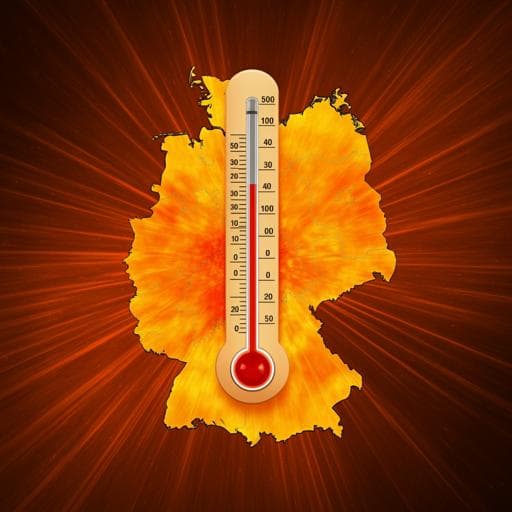
Health and Fitness
High-resolution modeling and projection of heat-related mortality in Germany under climate change
J. Wang, N. Nikolaou, et al.
Discover how a groundbreaking multi-scale machine learning model predicts a staggering 48,000 heat-related deaths in Germany from 2014 to 2023, predominantly during heatwaves. This vital study, conducted by Junyu Wang, Nikolaos Nikolaou, Matthias an der Heiden, and Christopher Irrgang, warns of a potential 2.5 to 9-fold increase in mortality by 2100 without crucial adaptation measures.
~3 min • Beginner • English
Introduction
The study addresses how high temperatures and heatwaves contribute to excess mortality and how to estimate these impacts at high temporal and spatial resolution. Against a backdrop of anthropogenic climate change—global mean surface temperature rise of ~1.2 °C since 1850–1900, with Europe warming ~2.2 °C—heatwaves are becoming more frequent, longer, and more intense, driving health burdens and mortality, particularly among older populations and in urban heat islands. Existing epidemiological models (e.g., GAMs, DLMs) often rely on aggregated weekly data and coarse spatial scales, missing cumulative heat effects and intra-regional variability, which hinders targeted public health planning. The research objective is to develop and validate a multi-scale machine learning framework that overcomes temporal and spatial scale mismatches to estimate daily, district-level heat-related mortality in Germany, attribute mortality to specific heatwaves, and project future risks under climate change scenarios.
Literature Review
Prior work commonly employs GAMs and distributed lag (non-linear) models to estimate temperature–mortality associations, but these approaches often treat daily effects independently, under-represent cumulative heatwave impacts, and depend on temporally and spatially aggregated inputs that bias estimates (e.g., weekly temperatures can underestimate heat-related excess mortality by ~20%). Studies show substantial recent heat-related mortality in Europe (e.g., ~60,000 deaths in 2022) and significant contributions from urban heat islands. German estimates attribute nearly 20,000 deaths to hot summers in 2018–2020. Evidence indicates a U- or J-shaped temperature–mortality curve with a minimum mortality temperature, and that mean and nighttime (minimum) temperatures can be stronger predictors of summer mortality than daily maxima. Literature also highlights the difficulty of defining heatwaves uniformly due to acclimatization/adaptation differences and shows a disproportionate share of annual heat-related mortality concentrated in a small fraction of very hot days.
Methodology
Data: Mortality counts from the German Federal Statistical Office included daily deaths by state and sex; weekly deaths by state, sex, and broad age groups (0–65, 65–75, 75–85, 85+); and weekly national deaths by sex and detailed age groups (0–30, 5-year groups 30–95, 95+). Population data by district, sex, and 5-year age groups (2011 onward) were interpolated to daily values; demographic projections to 2070 were used for scenario analyses at aggregate levels. Temperature data combined: CERRA reanalysis (2011–2020, 6-hourly), a 1×1 km daily min/mean/max product from Helmholtz Munich (with gaps infilled using CERRA and 2013 mean anomalies noted and excluded from metrics), and DWD station daily mean temperature from 537 stations (2010–2022) for near-real-time estimation. Geodata (district boundaries and reference points) came from BKG. Climate projections used EC-Earth3 ensembles (50 members) for SSP126/245/370 (2015–2100, ~100 km). ERA5 daily statistics at 0.5° were interpolated to EC-Earth3 grids to train a downscaling model.
Model for mortality: The framework predicts district-, age-, and sex-specific daily mortality as baseline(age, sex, time) × population(district, age, sex, time) × f_age,sex(T_lag), where f is a learned temperature-dependent multiplicative factor capturing lagged temperature effects via 1D convolutions over a window of lag days. Baselines were assumed uniform across districts within each age–sex group and time-varying; seasonal variation was implicitly captured by temperature rather than explicitly modeled. Predictions were aggregated to match available mortality data (daily state-level and weekly state/national groupings) and trained using a Poisson loss. Day-of-week correction factors were optionally applied before aggregation. Data were split 80:20 with 2011–2018 for training and 2019–2020 for validation. Two architectures were evaluated: (1) Linear model: fully connected network with ReLU and an initial 1D convolution to capture lags; (2) Exponential model: shallow network summing exponential terms f(T) = g(exp(g1(T)), …, exp(gd(T))) with affine transformations gi, non-negative scaling in g, producing multiplicative risk factors. To reduce variance, ensembles of multiple random initializations were trained and averaged; final setup used 20 members.
District temperature estimation: An attention-like spatial interpolation mapped station or model grid temperatures to district-level means: T_i = b_i + Σ_j w_ij T_j with w_ij ∝ exp(−a_i d(X_i, Y_j)), where X_i are trainable district coordinates, Y_j are station/grid coordinates, a_i are district-specific scales, and b_i biases. This captured local weather and implicitly the urban heat island. RMSE against the 1 km product: 0.23 °C (train) and 0.25 °C (validation).
Climate downscaling: A machine learning approach trained on ERA5 (0.5°) interpolated to EC-Earth3 grid to map coarse projections to district-level daily temperatures via the attention-like scheme; no explicit bias correction was applied. Projections assumed constant population and baseline mortality for main results, with additional non-static demographic scenarios to 2070 explored in supplement.
Statistics and reproducibility: Multiple instances per setup; performance reported via MSE and R²; final results averaged over 20 ensemble members.
Key Findings
- Estimated total of ~48,000 heat-related deaths in Germany from 2014–2023; most occurred during specific heatwave periods.
- Annual estimates (examples from Fig. 1): 2018 (~9,900), 2019 (~7,700), 2020 (~4,800), 2021 (~2,100), 2022 (~5,600), 2023 (~4,000). In text, 2023 total ~3,900 with the July 7–14 heatwave contributing ~1,100 deaths (~28%).
- Spatial patterns: Hotspot regions include western North Rhine-Westphalia (Ruhr), Saarland, northwest Baden-Württemberg, Berlin, Brandenburg, Saxony; urban heat islands evident with more warm days and higher risk in cities. Districts with ≥45 warm days (>20 °C mean) tend to have ≥100 heat-related deaths per million per year.
- Temporal dynamics: Clear lag between peak temperature and peak mortality risk (~up to 2–3 days). During July 7–14, 2023, national mean temperature peaked July 9 (24.5 °C); mortality risk peaked July 12 and persisted a day after heat abated. Most federal states (except several northern ones) exceeded 10 deaths per million over the event; Rhineland-Palatinate peaked at ~39 per million.
- Model performance: For warm days (nationwide mean >20 °C), daily national mortality RMSE ~91.4 (train) and ~83.9 (validation); R² ~0.79 (train) and ~0.83 (validation). Across all days, performance decreased (RMSE ~171–200; R² ~0.49–0.60) due to unmodeled influenza/COVID. Weekly performance vs RKI GAM for hot weeks (2011–2020, excluding 2013): RMSE 362.1 (this model) vs 364.9 (GAM); R² 0.8997 vs 0.8982.
- Future projections (assuming constant population and baseline mortality): By 2091–2100 median annual excess deaths ~3,700 (SSP126; ~40 per million), ~11,600 (SSP245; ~140 per million), and ~41,000 (SSP370; ~500 per million). Relative to today, increases of ~2.5× (SSP245) to ~9× (SSP370). Demographic change scenarios to 2070 add ~40–60% risk by ~2050 relative to static population.
- Concentration of risk: Top 10 days each year account for ~40–90% of annual heat-related mortality; only ~7% of days are isolated, underscoring the dominance of consecutive hot days (heatwaves).
Discussion
The study demonstrates that a multi-scale ML framework can reconcile temporal and spatial mismatches between climate and mortality data to estimate heat-related mortality at district/day resolution. The approach captures intra-urban variability (heat islands) and lagged impacts, enabling attribution of annual mortality to specific heatwave events and near-real-time risk assessment. Results indicate temperature is the primary driver of summer excess mortality: the model, using temperature alone without an explicit seasonal term, matched the accuracy of traditional GAM-based approaches for hot weeks. Mean temperature best explained summer mortality variability, with minimum (nighttime) temperature outperforming maximum temperature, aligning with literature on the lethality of hot nights. Comparisons suggest models using weekly averages and coarse regions (e.g., RKI reports) likely underestimate mortality due to attenuated variability and lag effects; when similarly aggregated, the present model aligns with RKI estimates. Projections show substantial, non-linear increases in heat-related mortality under continued warming, particularly in SSP245/SSP370, and demographic aging further amplifies risk. These findings emphasize the need for targeted heatwave-focused prevention and adaptation, and demonstrate the utility of integrating high-resolution climate information with public health analytics for planning and response.
Conclusion
This work introduces a high-resolution, multi-scale machine learning system that integrates temperature, population, and mortality data to estimate and project heat-related mortality in Germany. It quantifies a substantial recent burden (~48,000 deaths in 2014–2023), shows that a small number of extreme hot days dominate annual mortality, and reveals a lagged mortality response during heatwaves. Future scenarios without adaptation suggest increases of ~2.5× (SSP245) to ~9× (SSP370) by 2100, with demographic aging adding further risk. The model can support near-real-time district-level risk assessments, inform targeted interventions (especially for heatwaves and urban hotspots), and guide long-term resilience planning. Future research should refine regional exposure–response heterogeneity, incorporate healthcare improvements and adaptive capacity, evaluate intervention effectiveness, and extend analyses to age-specific vulnerabilities and other countries.
Limitations
- Uniform baseline mortality and temperature–mortality relationship were assumed across districts within each age–sex group; regional socio-demographic and climatic heterogeneity may necessitate stratified models for larger or more diverse areas.
- Temperature inputs, while high resolution, contain uncertainties (e.g., 1×1 km dataset RMSE ~0.90 °C vs other sources) and substantial within-district variability that is not captured, potentially biasing risk estimates.
- Climate downscaling was trained on ERA5 and applied to EC-Earth3 projections without explicit bias correction; differences between datasets may introduce biases in projected temperatures and excess mortality.
- Projections primarily assumed constant population and baseline mortality; while additional demographic scenarios to 2070 were explored, potential reductions in baseline mortality due to healthcare improvements and changes in adaptive capacity were not modeled. The learned exposure–response reflects current conditions and may shift with adaptation.
- Some training inputs (e.g., 2013 mean temperature irregularities) were retained for training but excluded from metric evaluation; mortality data beyond 2020 affected by COVID-19 were excluded from training/validation baselines, which may affect generalizability to pandemic-impacted periods.
Related Publications
Explore these studies to deepen your understanding of the subject.







